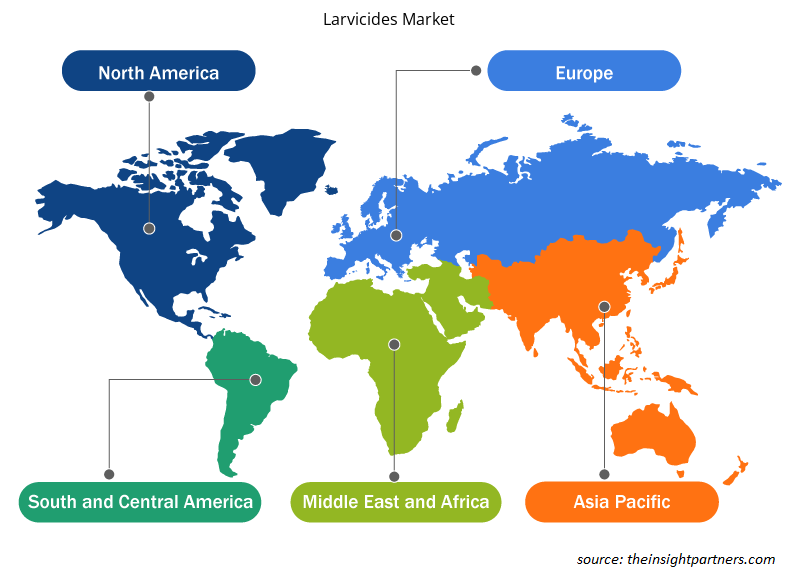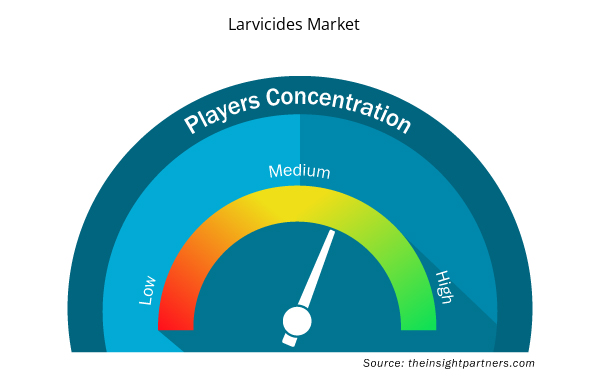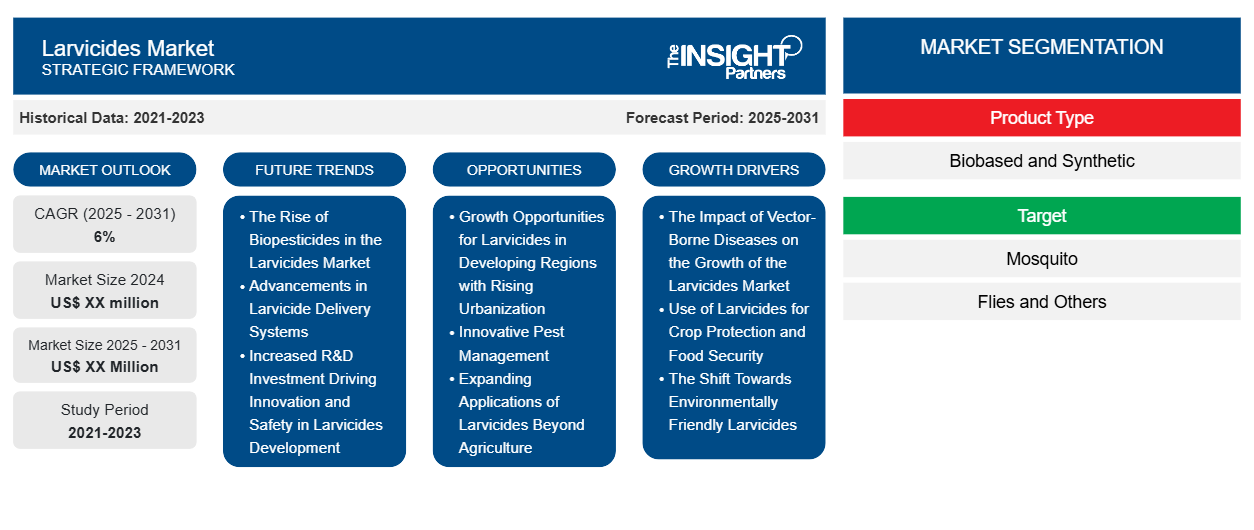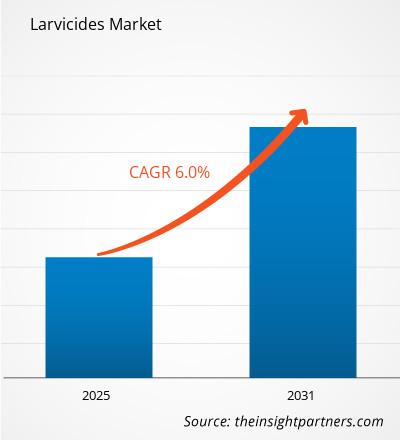Se espera que el mercado de larvicidas registre una CAGR del 6% entre 2023 y 2031, con un tamaño de mercado que se expandirá de US$ XX millones en 2023 a US$ XX millones en 2031.
El informe está segmentado por tipo de producto (de base biológica y sintético) y objetivo (mosquitos, moscas y otros). El informe presenta además un análisis basado en la aplicación (agrícola y no agrícola). El análisis global se desglosa aún más a nivel regional y de los principales países. El tamaño del mercado y el pronóstico a nivel global, regional y de país para todos los segmentos clave del mercado están cubiertos bajo el alcance. El informe ofrece el valor en USD para el análisis y los segmentos anteriores. El informe proporciona estadísticas clave sobre el estado del mercado de los actores clave del mercado y ofrece tendencias y oportunidades del mercado.
Propósito del Informe
El informe Larvicidas Market de The Insight Partners tiene como objetivo describir el panorama actual y el crecimiento futuro, los principales factores impulsores, los desafíos y las oportunidades. Esto proporcionará información a diversas partes interesadas del negocio, como:
- Proveedores/fabricantes de tecnología: Para comprender la dinámica cambiante del mercado y conocer las oportunidades potenciales de crecimiento, lo que les permitirá tomar decisiones estratégicas informadas.
- Inversionistas: Realizar un análisis exhaustivo de tendencias sobre la tasa de crecimiento del mercado, las proyecciones financieras del mercado y las oportunidades que existen en toda la cadena de valor.
- Órganos reguladores: Regular las políticas y vigilar las actividades del mercado con el objetivo de minimizar los abusos, preservar la confianza de los inversores y defender la integridad y la estabilidad del mercado.
Segmentación del mercado de larvicidas
Tipo de producto
- De base biológica y sintético
Objetivo
- Mosquito
- Moscas y otros
Solicitud
- Agrícola y no agrícola
Geografía
- América del norte
- Europa
- Asia-Pacífico
- América del Sur y Central
- Oriente Medio y África
Geografía
- América del norte
- Europa
- Asia-Pacífico
- América del Sur y Central
- Oriente Medio y África
Personalice este informe según sus necesidades
Obtendrá personalización en cualquier informe, sin cargo, incluidas partes de este informe o análisis a nivel de país, paquete de datos de Excel, así como también grandes ofertas y descuentos para empresas emergentes y universidades.
- Obtenga las principales tendencias clave del mercado de este informe.Esta muestra GRATUITA incluirá análisis de datos, desde tendencias del mercado hasta estimaciones y pronósticos.
Factores impulsores del crecimiento del mercado de larvicidas
- El impacto de las enfermedades transmitidas por vectores en el crecimiento del mercado de los larvicidas: La creciente carga mundial de enfermedades transmitidas por vectores, especialmente en las zonas tropicales y subtropicales, es un determinante principal del crecimiento del mercado de los larvicidas. Las enfermedades relacionadas con los riesgos para la salud, como la malaria, el dengue y el virus del Zika, exigieron medidas de control de los mosquitos, que las organizaciones sanitarias y los gobiernos adoptaron rápidamente. La necesidad de controlar los riesgos para la salud que plantean estas enfermedades ha hecho que los países inviertan más en programas de aplicación de larvicidas para prevenir su propagación. Con la urbanización y el crecimiento de la población, las soluciones prácticas para controlar la fase larvaria de estas plagas se vuelven primordiales para la protección de la salud pública.
- Uso de larvicidas para la protección de cultivos y la seguridad alimentaria: La creciente demanda de larvicidas también se nota en la agricultura, donde es necesario controlar los insectos que destruyen los cultivos. En vista del aumento de la producción mundial de alimentos, una mayor producción de alimentos requiere un mayor uso de pesticidas, incluidos los larvicidas, para proteger los cultivos de los ataques de plagas. Cada vez más agricultores están adoptando la gestión integrada de plagas (GIP), que también implica el uso de larvicidas para suprimir la fase larvaria de la plaga en cuestión. Esta tendencia respalda la expansión del mercado de larvicidas en el sector agrícola.
- El cambio hacia los larvicidas respetuosos con el medio ambiente: el interés por los insecticidas respetuosos con el medio ambiente y el llamamiento mundial a favor de prácticas más ecológicas están transformando el mercado. Los gobiernos y otras partes interesadas están fomentando cada vez más el uso de larvicidas seguros y biodegradables para proteger el medio ambiente de los efectos adversos. Desde entonces, se ha hecho hincapié en la producción de larvicidas seguros y naturales en el medio ambiente. Un cambio de paradigma hacia un control de plagas sostenible desde el punto de vista medioambiental ha aumentado la demanda de diseños novedosos y sostenibles de larvicidas.
Tendencias futuras del mercado de larvicidas
- El auge de los biopesticidas en el mercado de los larvicidas: Existe una creciente tendencia hacia el uso de biopesticidas en el mercado de los larvicidas. Los biopesticidas se obtienen a partir de plantas, bacterias o minerales en lugar de productos químicos sintéticos. Además, estos biopesticidas han llegado a desplazar a los sintéticos debido a su baja toxicidad hacia organismos y contaminantes no objetivo. Las inversiones en el área también dan como resultado larvicidas exitosos formulados de la manera menos peligrosa para la salud humana y el medio ambiente. También coincide con la preferencia de los clientes por estrategias de manejo de plagas orgánicas y ecológicas.
- Avances en los sistemas de administración de larvicidas: Los avances en los sistemas de administración de larvicidas ayudan a mejorar la eficiencia y eficacia de su aplicación. Con el uso de formulaciones de liberación lenta, encapsulación y sistemas de administración de larvicidas dirigidos, los larvicidas se aplican en un área específica en la concentración deseada con un desperdicio mínimo, mejorando el control. Estos avances permiten además la supresión prolongada de plagas problemáticas mediante el uso de larvicidas. Los mecanismos de administración mejorados también reducen la cantidad de veces que se debe realizar el tratamiento, lo que reduce el costo y el impacto ambiental de su aplicación.
- El aumento de la inversión en I+D impulsa la innovación y la seguridad en el desarrollo de larvicidas: se observan cambios notables en la asignación de fondos dentro del contexto de investigación y desarrollo (I+D) en el mercado de larvicidas especialmente diseñados. Las empresas buscan desarrollar ingredientes activos, formulaciones y aplicaciones orientadas a la mejora y la seguridad de los larvicidas. Esto tiene como objetivo fomentar enfoques innovadores en el mercado. Se han establecido alianzas con centros de investigación, universidades e instituciones agrícolas. El aspecto positivo de esta tendencia es que promueve el desarrollo de larvicidas más avanzados y se adhiere a las regulaciones ambientales y de seguridad durante su desarrollo.
Oportunidades de mercado para los larvicidas
- Oportunidades de crecimiento para los larvicidas en las regiones en desarrollo con una creciente urbanización: Se espera que el mercado de los larvicidas florezca en los países en desarrollo, especialmente en las regiones de Asia y el Pacífico, África y América Latina, donde la tasa de urbanización es más alta. Las ciudades en crecimiento tienen un mayor riesgo de enfermedades transmitidas por mosquitos, lo que crea la necesidad de medidas eficaces de control de vectores. Esta es una oportunidad que muchas de las empresas pueden aprovechar formulando larvicidas económicos y fáciles de usar específicos para las regiones en las que se necesitan.
- Manejo innovador de plagas: existe una variedad de prácticas de manejo de plagas que se pueden integrar con el uso de larvicidas. La aplicación dirigida de larvicidas mediante drones combinada con análisis de datos para evaluar la población de plagas hará que las medidas de control de plagas sean más eficientes y efectivas. Se emitirán larvicidas inteligentes que incorporen tecnología para monitorear los movimientos de las plagas en tiempo real y, a su vez, crear estrategias de manejo de plagas debido a las necesidades de agricultura de precisión de la población actual.
- Ampliación de las aplicaciones de los larvicidas más allá de la agricultura: la creciente necesidad de larvicidas no se limita únicamente a las actividades agrícolas. Por ejemplo, estas sustancias se pueden utilizar en la atención sanitaria, la gestión del agua y sus recursos y el diseño de zonas verdes para las ciudades, todo ello para evitar el contacto de las personas con los mosquitos. Esta diversificación ofrece a los fabricantes la oportunidad de acceder a nuevos mercados y aplicaciones, ampliando así su mercado objetivo e impulsando las ventas.
Perspectivas regionales del mercado de larvicidas
Los analistas de Insight Partners explicaron en detalle las tendencias y los factores regionales que influyen en el mercado de larvicidas durante el período de pronóstico. Esta sección también analiza los segmentos y la geografía del mercado de larvicidas en América del Norte, Europa, Asia Pacífico, Oriente Medio y África, y América del Sur y Central.

- Obtenga datos regionales específicos para el mercado de larvicidas
Alcance del informe de mercado de larvicidas
| Atributo del informe | Detalles |
|---|---|
| Tamaño del mercado en 2023 | XX millones de dólares estadounidenses |
| Tamaño del mercado en 2031 | US$ XX millones |
| CAGR global (2023 - 2031) | 6% |
| Datos históricos | 2021-2022 |
| Período de pronóstico | 2024-2031 |
| Segmentos cubiertos | Por tipo de producto
|
| Regiones y países cubiertos | América del norte
|
| Líderes del mercado y perfiles de empresas clave |
|
Densidad de actores del mercado de larvicidas: comprensión de su impacto en la dinámica empresarial
El mercado de larvicidas está creciendo rápidamente, impulsado por la creciente demanda de los usuarios finales debido a factores como la evolución de las preferencias de los consumidores, los avances tecnológicos y una mayor conciencia de los beneficios del producto. A medida que aumenta la demanda, las empresas amplían sus ofertas, innovan para satisfacer las necesidades de los consumidores y aprovechan las tendencias emergentes, lo que impulsa aún más el crecimiento del mercado.
La densidad de actores del mercado se refiere a la distribución de las empresas o firmas que operan dentro de un mercado o industria en particular. Indica cuántos competidores (actores del mercado) están presentes en un espacio de mercado determinado en relación con su tamaño o valor total de mercado.
Las principales empresas que operan en el mercado de larvicidas son:
- BASF SE
- Bayer AG
- Compañía Central de Jardinería y Mascotas
- Certis USA LLC
- Compañía Gowan
Descargo de responsabilidad : Las empresas enumeradas anteriormente no están clasificadas en ningún orden particular.

- Obtenga una descripción general de los principales actores clave del mercado de larvicidas
Puntos de venta clave
- Cobertura integral: el informe cubre de manera integral el análisis de productos, servicios, tipos y usuarios finales del mercado de larvicidas, proporcionando un panorama holístico.
- Análisis de expertos: el informe se compila sobre la base de un profundo conocimiento de expertos y analistas de la industria.
- Información actualizada: El informe asegura relevancia comercial debido a su cobertura de información reciente y tendencias de datos.
- Opciones de personalización: este informe se puede personalizar para satisfacer los requisitos específicos del cliente y adaptarse adecuadamente a las estrategias comerciales.
Por lo tanto, el informe de investigación sobre el mercado de larvicidas puede ayudar a abrir camino para descifrar y comprender el escenario de la industria y las perspectivas de crecimiento. Si bien puede haber algunas preocupaciones válidas, los beneficios generales de este informe tienden a superar las desventajas.
- Análisis histórico (2 años), año base, pronóstico (7 años) con CAGR
- Análisis PEST y FODA
- Tamaño del mercado Valor/volumen: global, regional, nacional
- Industria y panorama competitivo
- Conjunto de datos de Excel



Report Coverage
Revenue forecast, Company Analysis, Industry landscape, Growth factors, and Trends

Segment Covered
This text is related
to segments covered.

Regional Scope
North America, Europe, Asia Pacific, Middle East & Africa, South & Central America

Country Scope
This text is related
to country scope.
Preguntas frecuentes
Development of biopesticides is expected to be the key market trends
On the basis of geography, the larvacides market is classified into North America, Europe, Asia Pacific, Middle East and Africa, and South and Central America
The report can be delivered in PDF/Word format, we can also share excel data sheet based on request.
BASF SE; Bayer AG; Certis USA LLC; Gowan Company; Sumitomo Chemicals are some of the key players operating in the larvacides market
The Larvicides Market is estimated to witness a CAGR of 6% from 2023 to 2031
Growing public health concerns is driving the market growth
Trends and growth analysis reports related to Chemicals and Materials : READ MORE..
1. BASF SE
2. Bayer AG
3. Central Garden and Pet Company
4. Certis USA LLC
5. Gowan Company
6. Isagro Insecticides
7. Nufarm Limited
8. Russell IPM
9. Sumitomo Chemical Co., Ltd.
10. Summit Chemical Company
The Insight Partners performs research in 4 major stages: Data Collection & Secondary Research, Primary Research, Data Analysis and Data Triangulation & Final Review.
- Data Collection and Secondary Research:
As a market research and consulting firm operating from a decade, we have published and advised several client across the globe. First step for any study will start with an assessment of currently available data and insights from existing reports. Further, historical and current market information is collected from Investor Presentations, Annual Reports, SEC Filings, etc., and other information related to company’s performance and market positioning are gathered from Paid Databases (Factiva, Hoovers, and Reuters) and various other publications available in public domain.
Several associations trade associates, technical forums, institutes, societies and organization are accessed to gain technical as well as market related insights through their publications such as research papers, blogs and press releases related to the studies are referred to get cues about the market. Further, white papers, journals, magazines, and other news articles published in last 3 years are scrutinized and analyzed to understand the current market trends.
- Primary Research:
The primarily interview analysis comprise of data obtained from industry participants interview and answers to survey questions gathered by in-house primary team.
For primary research, interviews are conducted with industry experts/CEOs/Marketing Managers/VPs/Subject Matter Experts from both demand and supply side to get a 360-degree view of the market. The primary team conducts several interviews based on the complexity of the markets to understand the various market trends and dynamics which makes research more credible and precise.
A typical research interview fulfils the following functions:
- Provides first-hand information on the market size, market trends, growth trends, competitive landscape, and outlook
- Validates and strengthens in-house secondary research findings
- Develops the analysis team’s expertise and market understanding
Primary research involves email interactions and telephone interviews for each market, category, segment, and sub-segment across geographies. The participants who typically take part in such a process include, but are not limited to:
- Industry participants: VPs, business development managers, market intelligence managers and national sales managers
- Outside experts: Valuation experts, research analysts and key opinion leaders specializing in the electronics and semiconductor industry.
Below is the breakup of our primary respondents by company, designation, and region:

Once we receive the confirmation from primary research sources or primary respondents, we finalize the base year market estimation and forecast the data as per the macroeconomic and microeconomic factors assessed during data collection.
- Data Analysis:
Once data is validated through both secondary as well as primary respondents, we finalize the market estimations by hypothesis formulation and factor analysis at regional and country level.
- Macro-Economic Factor Analysis:
We analyse macroeconomic indicators such the gross domestic product (GDP), increase in the demand for goods and services across industries, technological advancement, regional economic growth, governmental policies, the influence of COVID-19, PEST analysis, and other aspects. This analysis aids in setting benchmarks for various nations/regions and approximating market splits. Additionally, the general trend of the aforementioned components aid in determining the market's development possibilities.
- Country Level Data:
Various factors that are especially aligned to the country are taken into account to determine the market size for a certain area and country, including the presence of vendors, such as headquarters and offices, the country's GDP, demand patterns, and industry growth. To comprehend the market dynamics for the nation, a number of growth variables, inhibitors, application areas, and current market trends are researched. The aforementioned elements aid in determining the country's overall market's growth potential.
- Company Profile:
The “Table of Contents” is formulated by listing and analyzing more than 25 - 30 companies operating in the market ecosystem across geographies. However, we profile only 10 companies as a standard practice in our syndicate reports. These 10 companies comprise leading, emerging, and regional players. Nonetheless, our analysis is not restricted to the 10 listed companies, we also analyze other companies present in the market to develop a holistic view and understand the prevailing trends. The “Company Profiles” section in the report covers key facts, business description, products & services, financial information, SWOT analysis, and key developments. The financial information presented is extracted from the annual reports and official documents of the publicly listed companies. Upon collecting the information for the sections of respective companies, we verify them via various primary sources and then compile the data in respective company profiles. The company level information helps us in deriving the base number as well as in forecasting the market size.
- Developing Base Number:
Aggregation of sales statistics (2020-2022) and macro-economic factor, and other secondary and primary research insights are utilized to arrive at base number and related market shares for 2022. The data gaps are identified in this step and relevant market data is analyzed, collected from paid primary interviews or databases. On finalizing the base year market size, forecasts are developed on the basis of macro-economic, industry and market growth factors and company level analysis.
- Data Triangulation and Final Review:
The market findings and base year market size calculations are validated from supply as well as demand side. Demand side validations are based on macro-economic factor analysis and benchmarks for respective regions and countries. In case of supply side validations, revenues of major companies are estimated (in case not available) based on industry benchmark, approximate number of employees, product portfolio, and primary interviews revenues are gathered. Further revenue from target product/service segment is assessed to avoid overshooting of market statistics. In case of heavy deviations between supply and demand side values, all thes steps are repeated to achieve synchronization.
We follow an iterative model, wherein we share our research findings with Subject Matter Experts (SME’s) and Key Opinion Leaders (KOLs) until consensus view of the market is not formulated – this model negates any drastic deviation in the opinions of experts. Only validated and universally acceptable research findings are quoted in our reports.
We have important check points that we use to validate our research findings – which we call – data triangulation, where we validate the information, we generate from secondary sources with primary interviews and then we re-validate with our internal data bases and Subject matter experts. This comprehensive model enables us to deliver high quality, reliable data in shortest possible time.


 Obtenga una muestra gratuita de este informe
Obtenga una muestra gratuita de este informe